Unpacking and publishing the Phaistos Disk since 1993
HOME | PREVIOUS | NEXT | SITEMAP







|
This is one of my old Phaistos Disk inspired websites, published when I was but 10 years into my project (still ongoing after 22 years). My updated site is Phaistos Disk Postcards in Clay
Claire Grace Watson (CGW): This opening paragraph by Sir Arthur Evans was published in 1909 at the beginning of Part III in his book "Scripta Minoa." The book was published only one year after the discovery of the Phaistos Disk, and that produces for me a question regarding these dates. It seems to me something is amiss because the disk was unearthed in 1908 by Dr. Luigi Pernier, who had drawings made and who then published his analysis in 1909, the same year this huge book by Evans went into print. Evans had little time to read Pernier's analysis, then write his own analysis, and then publish his analysis. (pp. 273-293) So it all happened very quickly. Sir Arthur, can you explain this?
Sir Arthur Evans (SAE):"While this volume was in the press a remarkable discovery of a hieroglyphic disk, made by the Italian Archaeological Mission at Phaestos, has introduced a wholly new element into the documentary evidence of early writing in Crete. The importance of this new material was such that its omission from the present work would have rendered it incomplete and unsatisfactory. Thanks, however, to the great courtesy of its discoverer, Dr. Luigi Pernier, I was at once supplied with photographs of the Disk, and was thus enabled to make a preliminary study of the inscription before the appearance of his own publication in 'Ausonia.'
CGW: Yes, I agree, whole new horizons and a circular maze puzzle out of which only Icarus can fly. And if my own analysis is not the decipherment of the Disk, at least after 10 years of wandering the spirals it lets me put on wings and fly away to some other obsession.
The sudden analysis by Evans of the Disk shows the depth of his knowledge of the picture writing of a civilization he also discovered, excavated and named. Can you imagine discovering and naming a civilization? Tell us, Sir Arthur, how this occurred and why the name you gave it stands the test of time?
SAG: "...the marvellous civilization of ancient Crete, to which in a comprehensive and generalized use of the word I have ventured to apply the word 'Minoan.'...As at least a convenient term of the prehistoric civilization of Crete, the word has now acquired a general currency in France, Italy, the United States, and our own country, as well as among many German scholars. In extending to the word a dynastic sense we have at least the warrant of the ancient tradition preserved by Diodoros, who, like Herodotos, seems to have drawn largely from Eteocretan sources, that there were two kings of the name of Minos. As I have pointed out elsewhere, the term 'Minoan' has at least the advantage of not transgressing the limits of ethnographic neutrality. To make use of 'Minos' like Caesar or pharaoh does not raise the vexed questions of Carians and Pelasgians, of the Achaeans, or even the Libyans. There may of course have been more than one early dynasty in prehistoric Crete, but the course of its civilization as a whole is continuous and homogeneous. The great Age of Cretan Palaces, moreover, suggests the idea of a centralized and dynastic government. The word 'Minoa' moreover, applied by the Greeks to so many early colonial offshoots of Crete fram Gaza to Western Sicily, seems to reflect the enterprise of its great prehistoric Age--when the sea-power of the Lords of Knossos was predominant throughout a large part of the Mediterranean basin. The archaeological corroboration of this conclusion is now coming out in the discovery of imported 'Minoan' objects from Palestine to Sicily and Spain."
CGW: Did anyone oppose your naming this civilization "Minoan"?
SAG:"It is true that my friend Professor Ridgeway, with his accustomed loyalty, has informed me that he is going to oppose the view that Minos I or II had any connexion with the great Palace Period of Knossos. He would bring the first Minos (with Diodoros, he distinquishes two), as the destroyer of the Palace, at the head of the first wave of fair-haired invaders in the Aegean."
CGW: And what is your response to this theory?
SAG: "Surely this is very hard on Minos. I can answer it by one "argumentum ad hominem." It was Minos not as destroyer but as builder of his Palace-shrine, the Labyrinth, and patron of the great craftsman, Daedalos, who led me to the site of Knossos. Had I not taken another view of ancient tradition this book at any rate would not have been written." (Ibid, pp. V-VI.)
CGW: Thank goodness you did not take that other view! Back to the Phastos Disk, no matter the dates and the rapid publication of his book, who can doubt Evans' ultimate authority on the pictographs and script of Minoan Crete? To his sudden analysis he brings so many years of ingenious work. And for anyone who studies the Disk and the civilization, his analysis is nothing less than stunning.
I began my own research of the Disk in 1993 when I happened upon a picture of the Phaistos Disk at the library. I was so amazed by it that I spent the next 10 years researching it and the civilization that is supposed to have produced it, but I never read this analysis by Evans until I had finished my own book when I thought perhaps to read what Evans had to say about it. I avoided reading his analysis until I had finished my book because I wanted to come up with something completely original out of my own life and researches. When I had finished my own analysis and then went on the Internet to see what anyone else had to say about the Disk, that is when I realized that I stood alone in the dark. And I suppose that is why I did not see Evans standing there with me.
When I knew I would need to look at Cretan pictographs and Minoan script to gain more insight, I also knew I did not want to do such extensive work. One cannot go back and become an archaeologist just to gain all this knowledge. Thankfully, Evans already did that and left a trail to follow. He is the authority, let him have it. I acquired "Scripta Minoa" through interlibrary loan and was lucky enough to get it. And I am thankful I did it this way because, like Evans says, my work has "at least the value of having been derived from an independent study." And I can congratulate myself on doing the best objective work a mystic knew how to do without being an archaeologist. That my own work, from the standpoint of religious philosophy and ancient mysticism, can dovetail with the scientific work of Evans just makes me elated. And it also gives me the courage to publish.
CGW: Sir Arthur, how did you acquire images of the Phaistos Disk so quickly after its discovery?
SAG: "Dr. Mariani, the editor of the ""Ausonia,"" has now supplied me with an advance copy of Dr. Pernier's full and excellent publication of the Disk, accompanied by detailed and careful drawings of the signs by Signor Stefani, together with photographs taken when the object was more fully cleaned. Finally, I have been able to study the Disk itself in the Museum at Candia. Under these circumstances it seems desirable to give a more detailed account of this unique hieroglyphic monument, and at the same time to examine the conclusions to which its discoverer has been led."
CGW: I have read on the Internet different accounts of where the disk was discovered and how it was discovered. For me as a writer I have been reluctant to rely on those accounts. I wonder if you can clear this up for me?
SAG: "The Disk itself was found in a rectangular repository, analogous to the 'Kaselles' of the Knossian Palace and of Hagia Triada. This repository formed part of an annexe to the Palace at Phaestos, which was brought to light under some Hellenistic constructions, outside its north-east angle. Although the soil within this rectangular cavity showed signs of disturbance and contained a few intrusive fragments, some of them of late Greek date, the prevailing character of the ceramic remains found in the same stratum with the Disk shows, as Dr. Pernier has rightly recognized, that they belonged to the concluding phase of the Third Middle Minoan Period. The painted vessels represented here and in some adjoining cists of the same character are in their general appearance identical with that both at Knossos and at Phaestos mark the close of the earlier Palace. They thus belong to the date of the 'Temple Repositories' at Knossos and to the stratum containing the alabastron lid inscribed with the name of the Hyksos King Khyan, the approximate date of which, as shown above, may be placed about 1600 B.C. It is in this stratum, at Knossos so widely extended, that inscribed documents of the Linear Class A first appear, and it is therefore of special interest to note that a broken tablet of this class was found in the repository with the Disk. To the full import of this fact there will be occasion to return."
CGW: Sir Arthur, can you tell me more about the disk? What is it made of, how big is it and how was it created?
SAG:
CGW: 48 unique stamps were used, not 45. In his haste, Evans completely missed 3 signs. There is a comparison later on. I had wondered what the stamps were made of but I assumed they also were constructed of clay. I had not given much thought to how this was accomplished - little clay stamps, I mean - but I also was not very interested in this aspect of the disk. I assume that potters are interested in this. I know at this time some potters on Crete are making reproductions of the disk and probably they have recreated these little stamps to do it. I have seen some crude reproductions that are not really worthy of the original, but I understand there are museum quality reproductions available. They can be ordered from a store in Crete, two at a time for about $45 USD each, shipping and handling included. I had heard the Hellenic Ministry of Culture has copyrighted the Disk and thus controls reproductions of it.
Sir Arthur, what can you tell us about all those line segments seen on the disk?
SAE: "Face A contains 31 sign-groups, separated from one another by incised lines, and containing 123 signs in all. Face B presents in the same way 30 groups and 118 signs. The total number of characters is thus 241, and of the groups, 61. The ends of the inscription on both sides of the Disk are marked by a line showing five punctuations. (I think this is an instruction to merge the two sides together at the puncture marks that appear at the matching line segments. Look closely and you can see the puncture marks. CGW) Another curious feature in the inscription, to be referred to below, is the marking off of certain signs at the beginnings of groups by a vertical or sloping dash below."
CGW: Now, here is something interesting. Evans and I agree on which is side A and which is side B. We also agree on the number of characters - 241 - but we are not in agreement about the number of signs on both sides. On side A, I count 121 and on side B, I count 120. Still, the total of 241 is the same. I would introduce here some information that the number 241 has a significance in Sothic calender dating (I read somewhere 241 is the number of days in a Sothic solar year, but I am still searching for that information). When we are saying that one side has 31 line segments and another has 30, then the thought "calendar" naturally occurs, although if it occurred to Evans he did not mention it. Perhaps he had no interest in ancient calendars, as neither do I. But later on I will have to take an interest. (And so I did, Minoan Calendars :)
We both observed as significant the lines at the end of the inscriptions on the both sides, the "line showing five punctions," as he calls it. We do not agree on the number of line segments, (I count 60) but later on in his analysis he suggests the possibility of 60 line segments and he gives the same reason as I do for that line segment count. Also, I had not given much import to the "vertical or sloping dash" under the signs as he did. I believe I thought they were scratches rather than marks having any meaning. I am presently looking into it and I hope, by the end of this book, to have come up with some conclusion about it.
Sir Arthur, have you seen anything like this spiral inscription on any of the other artifacts you have studied?
On the other hand, on some of the clay bars and labels from Knossos we see at times a curved and incipient spiraliform arrangement of the sign-groups which shows a certain affinity with the more elaborate ordering of the inscriptions on the Disk. The guiding lines above and below, with cross-divisions between the several sign-groups, also find analogies in the Minoan system. Horizontal lines accompany the inscriptions in both the linear classes, but on those the ends of the sign-groups are marked by short upright strokes or dots. In the case of some of the Minoan hieroglyphic inscriptions, however, we have both the guiding lines above and below, and vertical lines uniting them at intervals which mark the division between one sign-group and another."
This is one of my old Phaistos Disk inspired websites, published when I was but 10 years into my project (still ongoing after 22 years). My updated site is Phaistos Disk Postcards in Clay
CGW: Sir Arthur, will you provide us with your synopsis of the pictographs on the Disk?
SAG: Table XXIV contains a complete synopsis of the signs represented on the Disk. The figures are copied from my own tracings, and, though not so complete as the excellent drawings prepared by Signor Stefani for Dr. Pernier's publication, may yet have an independent value as regards some details.
It will be seen that the subjects group themselves into headings like those of the regular Minoan hieroglyphic series. Thus we have
CGW: The following are Sir Arthur's tracings, which apparently were rapidly done, along with my own beside each one of his. Numbers 46, 47 and 48 are the signs he overlooked. (In this book I enlarge some of the signs so their details will show.)
I reproduced the Disk by xeroxing a copy of it. I then placed tracing paper over each sign and traced it. Then, I xeroxed as many copies of each sign as I needed to reproduce it the number of times it appears on the disk. I cut out the signs and taped them back onto my tracing of the disk in the exact places where they appear. As far as I know, I am the only person to have done this, and for good reason. It takes days to do it and it is very tedious work but, as it turns out, pays well. Houghton-Mifflin publishing company found my drawing of side A of the Disk on the Internet and paid me a nice $800 for the privilege of using it on the cover of their college English composition textbook, Making Sense. This made sense to me also and it made my mother, an acrylic and oil artist, very proud. She had seen me "waste my time," as she often commented, researching the Disk. The money for the art seemed to vindicate me in her eyes, and she made a point of bragging about it to her friends and relatives. It was just great, although she died before she could see my art on the cover of the textbook. My Dad saw it, however, before he died and that almost made up for it.
CGW: 11 of these "marchers" appear on the disk, 6 on side A and 5 on side B. I do not know why Sir Arthur started with this sign or why he catalogues them in the certain order that he does, except that it appears he wanted to group them according to type, as listed in the categories above. 1 through 9 he calls "The human body and its parts (including articles of dress)." This makes sense when you consider that he had spent years digging up and catalogueing artifacts containing Cretan pictographs.
My own catalogue is more expanded than his and is not just limited to pictographic or physical representations but also includes the ideographic side or religious information that I could dig up. I want to continue his special order and add my own supplementary information to it. As for this sign, I do not see the slight crest and the indication of a crested helmet. Below are the possible meanings that can be ascribed to this sign. 1. Dionysis or God with the Bull's Foot - Twice this sign occurs alone in a line segment with the bull's foot sign, and in both cases a vertical or sloping dash is seen below the runner. Sir Arthur indicates these dashes give the pictographs special meaning. You can see this on his drawing of side A, line segments A 10 and A 17. Here is the significance I read into this 2-pictograph grouping.
I cling to the analysis of bull's foot, though, because I think it makes more sense in view of the prevailing religion of the times, which tended both toward and away from bull-worship after nearly 20,000 years of it. (I ought to footnote that 20,000 years comment but I write here extemporaneously and without many footnotes. I am expressing my opinions based on all the books I have read, and some of my opinions do not jibe with the books. I include a bibliography listing some of the books but mostly I am an opinionated writer. This might be my Magnum Opus, but I refuse to drive myself crazy with footnotes while writing it.) Perhaps this combination of pictographs could even be something like the running of the bulls in Pamplona, Spain. We know, or we think we know, that the Minoans played games with the bulls and held bull sporting events similar to rodeos, and we have images of bull leapers on the palace walls Knossos.
The story of the birth of Dionysis is interesting, especially in terms of some Cretan pictographs catalogued by Evans.
Semele, Dionysis' mother, got pregnant after having been seduced by Zeus, who appeared to her in the form of a serpent. Hera, wife of Zeus whose name is noticably an anagram for the Cretan Rhea, became jealous and convinced Zeus to appear to Semele in all his glory, which she knew would be the death of the human woman. After the conception of Dionysis his mother experienced the first case I have read of spontaneous human combustion. She was burnt to a crisp upon glimpsing Zeus, as Hera had planned. Dionysis as a fetus was rescued by his father from the ashes. Zeus slashed a hole in his thigh and stowed the fetus away in the wound. I think this is portrayed on this faceted stone of green Jasper from Siteia, Crete, where we see the fetus inside the thigh. (below) I have added a 3D image hoping to help the analysis along.
Footnote, Evans, pcms, p.21
I would like to add right here that it is not my intent to try to decipher these other pictographs collected by Evans or to come up with a system of doing so. I am just expressing my own observations and just some thoughts that occur to me. When I saw these pictographs I immediately thought, "Oh, look, it's Dionysis in Zeus' thigh." Suppose, for example, you happen to think that this is the fetus of Dionysis (what name did they give him, Rhadamanthus?) in the thigh of his father Zeus or Velchanos, then you can imagine that this sign shows something about the merger of these two gods in the merger of the comb with the cucumber. At any rate, in nine months a baby was born from the thigh of his father, and perhaps you might like to decipher the comb and cucumber as indicative of 9 months time. If you count each image and add to that the 4 tines in the comb, then you get a total of 9. Perhaps then it becomes a series of pictographs that show how long one expects to be with child, although it seems pretty remarkable to me that it has to do with two men, one of them pregnant with the other. That might be interpreted as indicative of a time in prehistory when the matriarchy or Earth Goddess society, as Evans calls it, was in the process of being superceded by the patriarchy.
The Cretans were supposed to have celebrated the drama of the life of Dionysis. What was the drama of his life that they re-enacted every two years? Is this it? Is this perhaps a commerative piece created for a biennial celebration of Dionysis? The story of the life of Dionysis parallels that of the legend of the Minotaur, also bull-born, who lived in the maze built by Daedalus. I personally think Daedalus was not an individual but was the Spirit of Invention in the Bronze Age. His name means cunning artificer, according to Evans, and it was this legend that led Evans to Crete to do his excavations. Daedalus was sort of a personified summary of mechanical skill, according to H.G. Wells, in an age when technology was itself being born - actually exploding - out of a past of hand-held stone implements and sticks and clubs. Now we are coming into the age of nautical advancements, and iron and bronze weaponry and tools. It was brilliant, to say the least, and deserving of a special name or personification. Dionysis was betrayed by a half-sister, as was the Minotaur, and other parallels can be seen in these lives of beings who were half-human and half-divine.
Here seems to be the old formula for a son of god in the Bronze Age, when people believed the divinity of a human could be demonstrated by bull's horns or bull's body parts. The king and queen at Knossos set up a palace with horns along the roof to establish that a divine son of Zeus lived there. But divine or no, the bull-being was destined to be slayed by Theseus, a mortal human, and so did Dionysis die at the hands of Hera's guards. Dionysis became the 13th Olympian, which we can surmise is the potential of the Minotaur and all the humans, half-beast, half-divine, who are caught in the maze of life and death. But Daedalus, who created the Minotaur's maze, also created a way out of it. We can escape by putting on the wings he created and fly to Mt. Olympus to take our place as divine Olympians where, apparently in the environment of infinite space, there is always room for one more.
That the Cretans held a biennial celebration of the life of Dionysis implies the use of a calendar. If you consider that the Phaistos Disk has two sides, each side with 30 or 31 line segments, then you can imagine it might be used to calculate a 2-year time span in which these celebrations would occur. With that mind, we can look a little closer at the Phaistos Disk as being perhaps a calendar just for this purpose.
The earliest form of picture writing might be said to be the identification of the constellations by drawing them from star to star or dot to dot, like connect-the-dots. Then, somehow, they came to be used as early forms of picture writing which, according to Evans, turned itself into Minoan script. Did you know our constellation names come from Crete and Greece? I would footnote that last remark but I have read it so many times I feel sure it is right. I specifically remember reading it in Encyclopedia of Astrology. That being said, it becomes possible that the Phaistos Disk is not only a calendar but may also be a constellation map, which puts it within the realm of a zodiac stellar calendar and sidereal timekeeper. Wouldn't that be something?! (It turns out the Phaistos Disk works perfectly as a zodiac stellar calendar and sideral timekeeper :)
Whatever the case, it seems obvious that some attempt was made to reproduce the constellation Taurus by connecting the Dionysis-God with the Bull's Foot signs, and that the comb and cucumber signs on the stone might be the name for this constellation. I think, also, we might want to allow the artist(s) who created the disk some leeway to get a constellation on there in as exact a copy as possible, given the circular disk parameters within which he/she was working. The star group below the constellation on the map is positioned directly above the boat on side B of the disk, which would have been a perfect place to place another Dionysis sign if you wanted the constellation to be drawn that way.
CGW: Evans' reference to p. 25 is the image in Part 1 of the crested invaders. This crested figure is found 14 times on side A and 5 times on side B. In the mythology associated with ancient Crete, Zeus was supposed to have been born in a cave on Crete - humble beginnings for a god but somehow familiar. He had five siblings born ahead of him who were eaten by his father, Cronos (Time), and so his life was in the balance. His mother Rhea hid him in the cave and then invented the Dance of the Labyrinth (Kronou Teknophagia or Crane Dance or Armed Dance) to amuse Zeus and to protect him.
Rhea stationed 9 warriors around Zeus who banged on their shields so that Chronos could not hear the cries of the baby. Then, she taught the Armed Dance to her priests, the Curetes, those with the shaved heads who lived in Crete, and they taught it to the crested dancers or dancing Curetes. The dance was preserved as a tradition re-enacting the cosmic drama of the birth of Zeus and became known as the Dance of the Labyrinth or the Crane Dance. It is still danced today all over the world. I believe this warrior is not a crested invader but a crested dancer, a dancing Curete who dances the Armed Dance. He appears along with a shield 12 times on the Disk. On side A he appears 14 times, which is a good number for him to be appearing if we are counting the number of divine Curetes associated with the birth of Zeus - 9 warriors that Rhea stationed around the baby plus the 5 Dactyls or immortal Curetes to whom Rhea entrusted the care of Zeus.
The Pythagoreans of a later ancient age understood the vertex to mean the point opposite to and farthest from the base of a triangle, pyramid, or any figure having a base. Use your imagination to draw a straight line from the vertex above to the base of the pyramid below.
Geometry seems to have originated with the study of the vertex-vortex and involved, pre-eminently, the triangle and its uses in describing the properties of a circle and the geometry of the sphere for use in astronomy. To the Pythagoreans, the triangle was the most sacred of geometries and was supposed to represent the plain of truth or the hearth of the universe. Therefore, it is appropriate to find it at the center with the god inside. (above, side A) To say that the Minoans had no knowledge of this Bronze Age science is to deny they were quite possibly major contributors and that they laid the groundwork for the later brilliance of Golden Age Greece. To always give that credit to the Babylonians and Egyptians is to deny this Minoan brilliance while embracing their other accomplishments. And so far, what we find on the Phaistos Disk begins to appear as an undeniable record of what they did know about these things. It also reveals a time in the world when these two sciences, geometry and astronomy, were united as one great and sacred science. The angles were angels, they were the stars in the sky and the gods and goddesses in heaven, and all of it immortal, so that religious philosophy was the third part of this sacred science, this geometry theology.
CGW: This sign appears twice on side A. I agree with the tattoo analysis. I think it is a tattoo of a rope truss, which was a very advanced (for the times) nautical technology in the Bronze Age. The rope truss stiffened the beam of the ships and was not known to be in use again until the days of modern engineering. (H.G. Wells, p.151, quoting from Torr's Ancient Ships) I think this rope truss tattoo marks this figure as a Minyae or Argonaut, which is the same thing as saying he is a Divine Curete. It indicates a geneology stemming from the Argonauts. I think also that Minos is related to the word Minyae and also indicates a divine heritage. Below is an image of a rope truss in use on an Egyptian ship. The Minyae were oarsmen on the Argos. With that knowledge at hand, the sign following this Minyae and the other one on the Disk can be identified, not as the feather that Evans thinks it is, but as an oar.
CGW: Warrior, Dactyl, Ares, Planet Mars. If you study the disk you will see that the shield is very close to Evan's "captive," so close as to be clearly part of it.
SAG:5. Naked male child. The characteristic outlines of the forepart of the body, the helpless attitude, and the comparatively small size of the figure sufiiciently warrant this interpretation (Pernier, No. 3).2
6. Woman with the breasts apparently bare, wearing a girdle, a short gown, and a skirt below. An object seems to hang from her girdle. The arrangement of the hair as noted above curiously recalls that of the male Shardanas of the time of Rameses II. The whole aspect of this figure with its exaggerated breadth of waist contrasts strongly with the Minoan and Mycenaean female types.
7. I have taken this sign to represent a woman's breast. Dr. Pernier would see in it a pileus or cap. I have suggested below that the breast sign is the symbol of a female divinity.
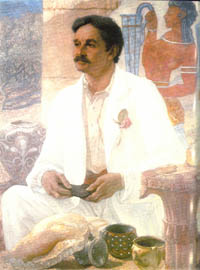 Sir Arthur Evans (SAE):"THE summary account of the Phaestos Disk which appears in Part I of this volume, I derived from a preliminary study of the photographic copies courteously supplied me by Dr. Pernier, was already in print before I had the advantage of studying the results arrived at by the discoverer himself. This circumstance is, in some respects, not without its advantages, since the provisional conclusions to which I was led in the earlier part of this work have at least the value of having been derived from an independent study."
Sir Arthur Evans (SAE):"THE summary account of the Phaestos Disk which appears in Part I of this volume, I derived from a preliminary study of the photographic copies courteously supplied me by Dr. Pernier, was already in print before I had the advantage of studying the results arrived at by the discoverer himself. This circumstance is, in some respects, not without its advantages, since the provisional conclusions to which I was led in the earlier part of this work have at least the value of having been derived from an independent study."


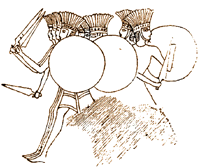 In Part III of this volume, which is devoted to this unique record, I have had the advantage of comparing his results and of studying the Disk itself at first hand. It will be seen that the hieroglyphic system represented by it differs from the ordinary Minoan type. The crested head-pieces "(left)" that appear among the characters recall, on the other hand, the familiar headgear of the later invaders "(right)" of the Delta from across the 'Great Green Sea', among whom the Philistines are grouped, and within whose orbit, later on, the Achaeans move. Moreover, a remarkable pagoda-like building "(left)" repeated on the Disk will be seen to find its best parallels in the traditional Lycian architecture. It looks, therefore as if the hieroglyphic system of the Disk may possibly be the product of some advanced culture, parallel with and allied to the Minoan, existing on the Western coastland of Asia Minor. Whole new horizons of investigation are opened out by this discovery." (Preface, "Scripta Minoa", pp. xiii-ix.)
In Part III of this volume, which is devoted to this unique record, I have had the advantage of comparing his results and of studying the Disk itself at first hand. It will be seen that the hieroglyphic system represented by it differs from the ordinary Minoan type. The crested head-pieces "(left)" that appear among the characters recall, on the other hand, the familiar headgear of the later invaders "(right)" of the Delta from across the 'Great Green Sea', among whom the Philistines are grouped, and within whose orbit, later on, the Achaeans move. Moreover, a remarkable pagoda-like building "(left)" repeated on the Disk will be seen to find its best parallels in the traditional Lycian architecture. It looks, therefore as if the hieroglyphic system of the Disk may possibly be the product of some advanced culture, parallel with and allied to the Minoan, existing on the Western coastland of Asia Minor. Whole new horizons of investigation are opened out by this discovery." (Preface, "Scripta Minoa", pp. xiii-ix.)
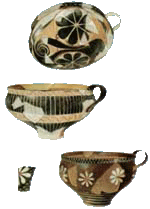 "The Disk itself is composed of such refined clay that it is compared by Dr. Pernier with the material of the 'egg-shell' cups (right) of the Knossian Palace fabric. Dr. Mackenzie, however, who is a specially competent judge in such matters, is of opinion that the clay is not Cretan. The Disk is not perfectly round, the diameter varying from 158 to 165 millimetres, while its thickness is from 16 to 21. The characters were stamped in relief with punches when the clay was wet, each separate variety of sign being impressed in all cases by the same stamp, so that the total number of the stamps used was thus 45, answering to the number of the signs. Dr. Pernier suggests that their material was hard wood or ivory. It seems possible, however, that they were of metal cast in matrices of engraved steatite." (Turns out much of this is incorrect but is the natural assumptions he would make when working with photographs of the disk. CGW - How it was made)
"The Disk itself is composed of such refined clay that it is compared by Dr. Pernier with the material of the 'egg-shell' cups (right) of the Knossian Palace fabric. Dr. Mackenzie, however, who is a specially competent judge in such matters, is of opinion that the clay is not Cretan. The Disk is not perfectly round, the diameter varying from 158 to 165 millimetres, while its thickness is from 16 to 21. The characters were stamped in relief with punches when the clay was wet, each separate variety of sign being impressed in all cases by the same stamp, so that the total number of the stamps used was thus 45, answering to the number of the signs. Dr. Pernier suggests that their material was hard wood or ivory. It seems possible, however, that they were of metal cast in matrices of engraved steatite." (Turns out much of this is incorrect but is the natural assumptions he would make when working with photographs of the disk. CGW - How it was made)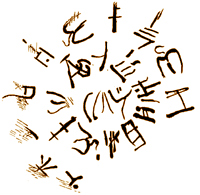 SAE: "It will be seen that the arrangement of the inscriptions on both sides of the Disk, winding outwards from the centre, presents a prima facie resemblance to that of an inscription of the Linear Class A written in some kind of ink in the inside of a cup from the Palace site of Knossos. "(left)" In that case, however, the inscription is not, as is the present one, spiral and continuous, but consists of two concentric rings of writing round the initial group.
SAE: "It will be seen that the arrangement of the inscriptions on both sides of the Disk, winding outwards from the centre, presents a prima facie resemblance to that of an inscription of the Linear Class A written in some kind of ink in the inside of a cup from the Palace site of Knossos. "(left)" In that case, however, the inscription is not, as is the present one, spiral and continuous, but consists of two concentric rings of writing round the initial group.
BY SIR ARTHUR EVANS - SCRIPTA MINOA
I-9. The human body and its parts (including articles of dress).
10-23. Arms, implements, and utensils.
24. A building.
25. A ship.
26-34. Animals and their parts.
35-39. Plants and trees.
40-45. Uncertain objects.

 SAG:1. Marching figure of a man in short tunic and belt. The crown of his head shows a slight crest which is possibly due to a summary attempt to indicate that he is wearing a crested helmet.
SAG:1. Marching figure of a man in short tunic and belt. The crown of his head shows a slight crest which is possibly due to a summary attempt to indicate that he is wearing a crested helmet.

![]() According to various histories I have read, every two years the Cretans celebrated the birth and death of Dionysis. They summoned him from the marshes with sea-shell trumpets, calling for the God with the bull's foot to come to them. They sang, Come hither, Dionysus, to thy holy temple by the sea; come with the Graces to thy temple, rushing with thy bull's foot, O goodly bull, O goodly bull! Plutarch writes that in Greece was celebrated the Mysteries of Dionysus, (89) and the women invoked him by praying for "the god with the bull's foot to come" to them. The bull's foot is actually upside-down on the disk, which makes it difficult to identify. As far as I know, Sir Arthur and I are the only ones to catalogue it as a bull's foot, although he calls it an ox's foot. That might be right because the Disk also shows a yoke pictograph, and probably oxen were yoked and not bulls. (Mostly likely, it's both. CGW)
According to various histories I have read, every two years the Cretans celebrated the birth and death of Dionysis. They summoned him from the marshes with sea-shell trumpets, calling for the God with the bull's foot to come to them. They sang, Come hither, Dionysus, to thy holy temple by the sea; come with the Graces to thy temple, rushing with thy bull's foot, O goodly bull, O goodly bull! Plutarch writes that in Greece was celebrated the Mysteries of Dionysus, (89) and the women invoked him by praying for "the god with the bull's foot to come" to them. The bull's foot is actually upside-down on the disk, which makes it difficult to identify. As far as I know, Sir Arthur and I are the only ones to catalogue it as a bull's foot, although he calls it an ox's foot. That might be right because the Disk also shows a yoke pictograph, and probably oxen were yoked and not bulls. (Mostly likely, it's both. CGW)
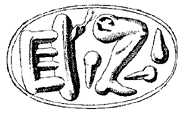
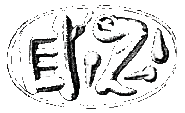
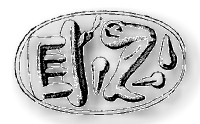
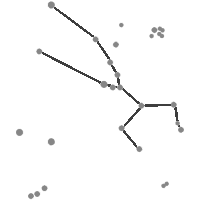 The symbols that preceed the fetus in the thigh are often catalogued by Sir Arthur because they recur so many times and in various or alternate depictions. They look like a comb (Evans originally called it a fence) and a smoking cucumber. Then the thigh is surrounded by three images, all similar, that appear to be nails but that I think are really stars. I believe this grouping indicates a constellation, possibly Taurus, (left) and the comb and smoking cucumber spell out the name of the constellation which is also the Cretan names, whatever they were, for Zeus and Dionysis. Will Durant, in Life of Greece says their name for Zeus was Velchanos (Vel-ka-nos). We think of the constellation Taurus as a bull, but classical Greeks apparently thought of it as Zeus disguised as a bull. Perhaps the Cretans thought of the constellation as Dionysis concealed in the thigh of Zeus, who was disguised as a serpent. Will we ever know? (Years later I found what I think is the constellation Taurus on the Phaistos Disk.)
The symbols that preceed the fetus in the thigh are often catalogued by Sir Arthur because they recur so many times and in various or alternate depictions. They look like a comb (Evans originally called it a fence) and a smoking cucumber. Then the thigh is surrounded by three images, all similar, that appear to be nails but that I think are really stars. I believe this grouping indicates a constellation, possibly Taurus, (left) and the comb and smoking cucumber spell out the name of the constellation which is also the Cretan names, whatever they were, for Zeus and Dionysis. Will Durant, in Life of Greece says their name for Zeus was Velchanos (Vel-ka-nos). We think of the constellation Taurus as a bull, but classical Greeks apparently thought of it as Zeus disguised as a bull. Perhaps the Cretans thought of the constellation as Dionysis concealed in the thigh of Zeus, who was disguised as a serpent. Will we ever know? (Years later I found what I think is the constellation Taurus on the Phaistos Disk.)
 2. Heracles - Alternately, this might not be Dionysis at all. It could, instead, symbolize Heracles, the first Olympiac champion, who made his fame by winning the foot race, the only kind of game they had at that time. Heracles was one of the original five divine Curetes, along with Idas, both of whom were Argonaut oarsmen on the Argos. In studying this old age we vary between facts as we can find them of Minoan Crete and the myths that come out of the Heroic Age, and hard to tell the difference, for me at least. But it is possible that the Phaistos Disk contains one or more of these great legends that came out of the Heroic Age of Greece, so many of which apparently were delineated in the stars by the ancient Cretans and classical Greeks.
2. Heracles - Alternately, this might not be Dionysis at all. It could, instead, symbolize Heracles, the first Olympiac champion, who made his fame by winning the foot race, the only kind of game they had at that time. Heracles was one of the original five divine Curetes, along with Idas, both of whom were Argonaut oarsmen on the Argos. In studying this old age we vary between facts as we can find them of Minoan Crete and the myths that come out of the Heroic Age, and hard to tell the difference, for me at least. But it is possible that the Phaistos Disk contains one or more of these great legends that came out of the Heroic Age of Greece, so many of which apparently were delineated in the stars by the ancient Cretans and classical Greeks.
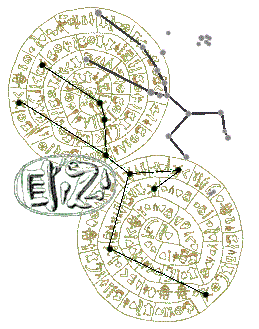 Left, the 11 Dionysis-God with the Bull's Foot signs are dotted and connected, six on side A and 5 on side B, with lines to see if something discernible will appear, perhaps a recognizable constellation. There are various ways to connect these dots and, except for one star, connecting these dots while looking at the constellation Taurus creates an near exact copy of the constellation. One star is really out of place, so perhaps another star was used to complete this Minoan Crete version of Taurus, just as the star far below the constellation map appears to be the one used to draw the constellation on the disk. (You can barely see it on this image. See the constellation above to see lone star group directly below the constellation.)
Left, the 11 Dionysis-God with the Bull's Foot signs are dotted and connected, six on side A and 5 on side B, with lines to see if something discernible will appear, perhaps a recognizable constellation. There are various ways to connect these dots and, except for one star, connecting these dots while looking at the constellation Taurus creates an near exact copy of the constellation. One star is really out of place, so perhaps another star was used to complete this Minoan Crete version of Taurus, just as the star far below the constellation map appears to be the one used to draw the constellation on the disk. (You can barely see it on this image. See the constellation above to see lone star group directly below the constellation.)

![]() SAG:2. Head of a man in close-fitting crested helmet. For comparisons with the head-gear of the Pulasati, &c., and of a figure on the Enkomi casket see above, p. 25.
SAG:2. Head of a man in close-fitting crested helmet. For comparisons with the head-gear of the Pulasati, &c., and of a figure on the Enkomi casket see above, p. 25. If we dot these crested dancers and connect the dots with lines, we get perhaps the image of their stations around the baby as we go deeper inside the cave. If we designate the flower at the center of the disk as Zeus, we can see the 8-petaled wonder of the god inside his protective triangle, and also notice the head of Dionysis-God with the Bull's Foot inside the pyramid with the flower (Zeus). The sunflower might suggest his level of divinity as equivalent to that of the Egyptian sun god Ra or perhaps it represents something like the Egyptian Ogdoad, Thoth's celestial City of 8 which is 8th sphere and highest heaven.
If we dot these crested dancers and connect the dots with lines, we get perhaps the image of their stations around the baby as we go deeper inside the cave. If we designate the flower at the center of the disk as Zeus, we can see the 8-petaled wonder of the god inside his protective triangle, and also notice the head of Dionysis-God with the Bull's Foot inside the pyramid with the flower (Zeus). The sunflower might suggest his level of divinity as equivalent to that of the Egyptian sun god Ra or perhaps it represents something like the Egyptian Ogdoad, Thoth's celestial City of 8 which is 8th sphere and highest heaven.
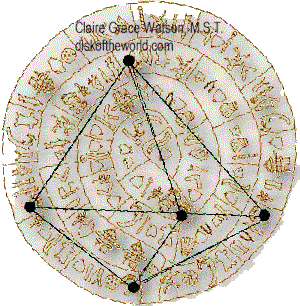 The sun/flower at the center of the Disk is also the vertex of the disk. When we look at side B to see what we get by dotting and connecting the crested dancers, something emerges that looks like mirroring pyramids. Though not perfectly symmetical a vertex is present. The spiral on the Disk suggests a vortex, which means to turn or rotate. Vortex has a correlation to vertex, which is the zenith or point in the heavens directly overhead.
The sun/flower at the center of the Disk is also the vertex of the disk. When we look at side B to see what we get by dotting and connecting the crested dancers, something emerges that looks like mirroring pyramids. Though not perfectly symmetical a vertex is present. The spiral on the Disk suggests a vortex, which means to turn or rotate. Vortex has a correlation to vertex, which is the zenith or point in the heavens directly overhead.


![]() SAG:3. Head of a man depicted as bald, or with a close-fitting cap. An 8-shaped mark is visible on the cheek. This, as Dr. Pernier has suggested may indicate a tattoo mark, or a painted ornament such as appears on certain Minoan figures.
SAG:3. Head of a man depicted as bald, or with a close-fitting cap. An 8-shaped mark is visible on the cheek. This, as Dr. Pernier has suggested may indicate a tattoo mark, or a painted ornament such as appears on certain Minoan figures.

 SAG:4. Naked man with his arms bound behind his back; evidently a captive.
SAG:4. Naked man with his arms bound behind his back; evidently a captive.
`